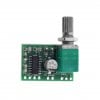I got the amp yesterday, and today had a chance to do a mock up... it works! Roughly, it's about like a small handheld radio that's ok at low volumes and obnoxious after 1/2 way. I went through some parts I had and found a pair of 3" speakers from a Sylvania tv. They are lightweight speakers with real small magnets and are 8Ω not 4Ω so I was concerned they'd be low in volume but they aren't. This is for watching documentaries, how-to videos, interviews... which is what I like to do before I go to sleep, and the iBook's speakers don't cut it.
There's zero problem with powering it from the USB port, works fine. For the volume I need the volume control on the amp is 1/3 of the way up. That's perfect. It's very clear and when I unplug the input and crank it full there's no noise problem.
The main problem is that the sound sucks. The sound is cold, small and the ratio of low end to high is out to lunch, WAY too much treble. The problem is the speakers, not the amp. As soon as I settle on the speakers I'll make a wood cabinet and the wood will change the sound totally, but the speakers need to be closer than what I have now. To make it small likely the big speaker will face forward and the small one will be on the top of the speakerbox.
Since I really only want mono what I'm thinking now is to bridge the left and right channels at the input and use one side of the amp to power a larger speaker and the other side to power a smaller speaker, maybe even one of the 3" ones. It would probably sound better if I could make the smaller speaker get less power. I wouldn't mind having a passive low pass tone control on the input because the sound is like an upside down triangle if you know what I mean.
This isn't a serious project, more just having fun and learning. I have a S5 tube amp kit I put together and a 70's Harmon Kardon stereo amp that sound great and I'm not expecting to rival those.
Probably the most amazing thing for me is that I can get a little amp that actually is clear for about the price of a chocolate bar.
BTW I had to get a new soldering iron today and Radio Shack has a coupon on their site that gives you $10 off of a $25 purchase, instore or online.




